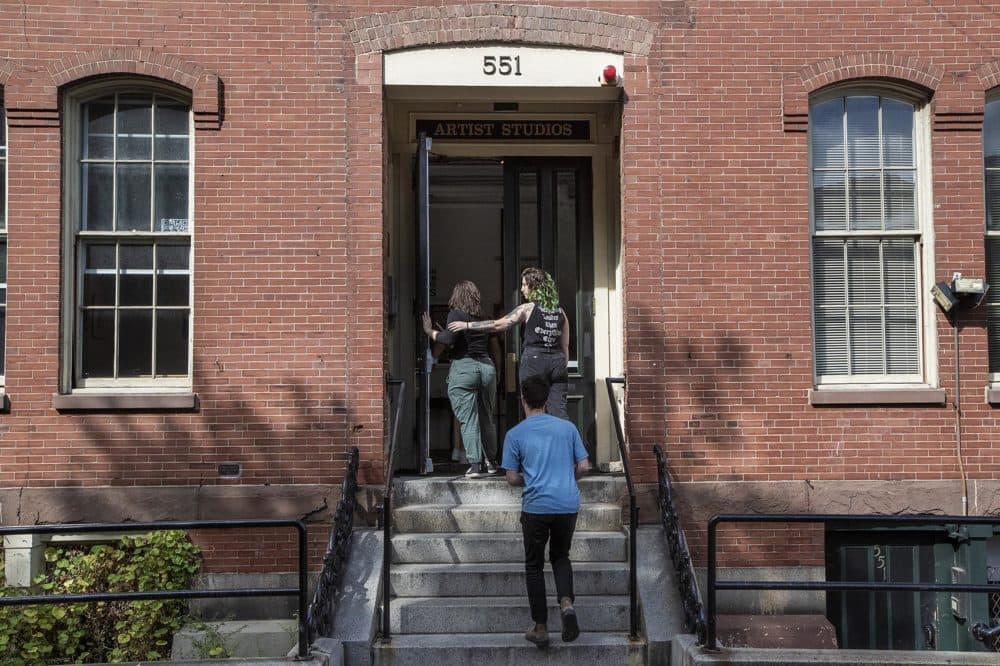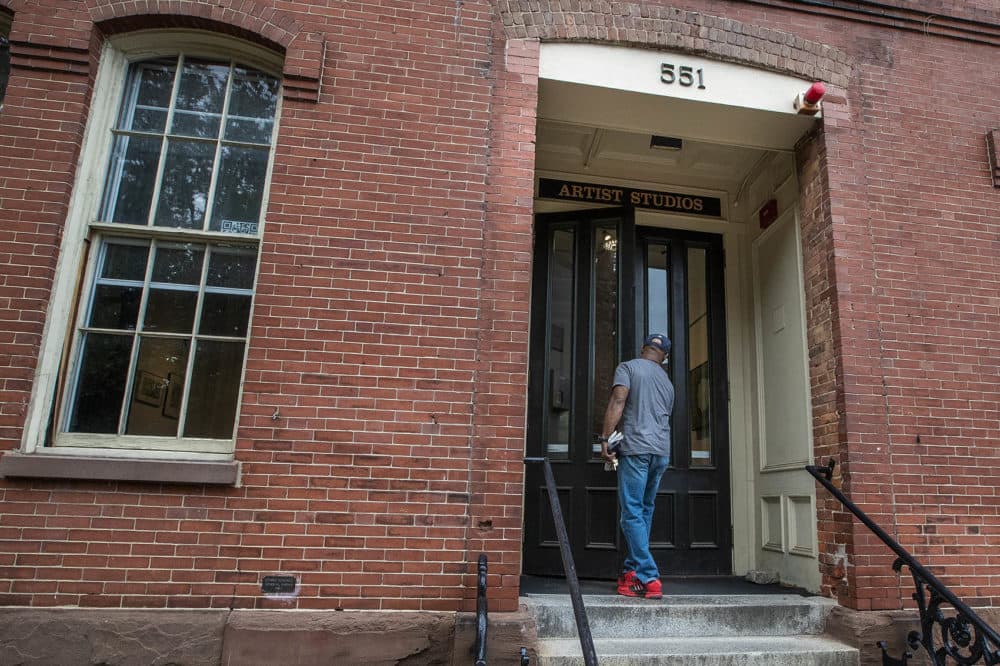Advertisement
In The BCA’s New Residency Program, The Story Of Artist Displacement Is Different Than The Familiar Script

By now, it’s a familiar story in Boston: a long-standing artist community suddenly finds itself without a home, the victim of surging real estate values and rising rents. Eulogies for the lost studios are posted on social media. People decry the increasingly untenable conditions for artists in the city. The community mourns.
Last month, the decades-old community of artists renting studios at the Boston Center for the Arts became the latest group to face displacement. But in this case, no developer had swept in to turn the building into condos, nor had the landlord suddenly doubled the rent. Instead, artists, craftspeople and arts organizations renting space in the creaky, four-story brick building will be displaced by … more artists.
The BCA announced the decision at the end of September as part of a sweeping new plan for a multi-tiered residency program, called “Studio 551,” that will begin in July. The residencies are open to artists working in visual arts, dance, theater and music and range in length from six months to six years. BCA leadership characterized the program as a response to the dearth of affordable studio space in Boston, arguing that it would be more equitable and serve more artists than the current model, in which artists leased studios at about one-third market rate without time limits.
But the decision means that 40 current tenants, some who have been renting studio space in the building for more than 40 years, will have to vacate their studios by May, unless they apply and are accepted into the residency program. (The BCA is addressing the future of its resident theater companies on a case-by-case basis.) Artists said they had been been blindsided by the BCA’s announcement, which came at a meeting that was pegged to the organization’s 50th anniversary. “No dialogue, no nothing,” said Miriam Shenitzer, a visual artist and animator who has been in the building since 1998. “So it really hurt.”
Word ricocheted across social media, prompting an outpouring of support for the artists. But others defended the decision, saying it would allow more artists access to coveted studio space.
The polarized response to the BCA's announcement throws into stark relief the intense pressures on both artists and arts organizations in Boston. Rapidly rising rents make it increasingly difficult for artists to live and work in the city, and a 2018 study commissioned by the mayor’s office found a severe lack of affordable rehearsal space for performing artists in particular.
The change also comes at a tumultuous time for the BCA. A little over a week after the organization announced Studio 551, its president and CEO Gregory Ruffer stepped down amid allegations of misconduct from about a decade ago. In a post on the classical music blog schmopera.com, tenor Wes Hunter accused Ruffer of sending him anonymous, sexually inappropriate emails while Hunter was a student at the College of Central Florida and Ruffer was his voice teacher. After BCA staff delivered a letter to the board asking that Ruffer be placed on leave while the BCA conducted an investigation, Ruffer resigned. The organization has contracted Boston-based Goodwin Procter LLP to conduct an internal review and examine Ruffer's interactions with employees at the BCA during his tenure there, according to Chairman of the Board John G.F. Ruggieri-Lam.
Co-interim director Emily Foster Day said that Ruffer’s resignation does not change the BCA’s plans for the new residency program. “We are fully committed, I and co-director Kristi [Keefe], in the interim, to move this program forward because we feel like it’s an important initiative and an important resource for Boston,” Day said.

The BCA occupies a distinct space in the Boston arts world. Its history begins in the late 1960s, when the city bought a parcel of land in the South End with the purpose of creating an arts center. The purchase included the Cyclorama, a vast building originally constructed to display a giant painting of the Battle of Gettysburg. Today the Cyclorama’s domed roof peeks out over a cluster of buildings operated by the BCA that houses three theaters, a black box, rehearsal halls, an art gallery and the studios at 551 Tremont, which the BCA rents from the city for $1 under a 99-year lease. Its artist tenants represent a range of practices, from painting to printmaking to ceramics to film. Some, like the sculptor Robert Rovenolt and the painter Aileen Erickson, have been renting studios since the 1970s, long before the South End was the chic arts district it is today. Others, like the interdisciplinary artists Rashin Fahendej and Allison Maria Rodriguez, represent a newer cohort of young, diverse artists primarily working in contemporary mediums.
Some say the BCA’s pivot from long-term studio leases to artist residencies reflects an eagerness to move with the times. Residencies have grown more popular in recent years; the BCA’s program bears some resemblance to the popular Smack Mellon residencies in Brooklyn, which were created to address the dearth of affordable studio space in the city. The move can also be read as an attempt to increase diversity at the BCA, a goal arts organizations increasingly prioritize and which is alluded to in the website's description of the new program. (About 75% of the BCA's current tenants are white, according to the organization's estimates, which did not ask artists to self-identify.)
But in its haste to evolve, some artists said, the BCA was tossing aside an older community of artists that helped make the place what it is today. When artists first moved into the South End, the neighborhood was considered dangerous, and the building was extremely run-down. Erickson began renting space at the BCA in 1973. The rooms were sometimes so cold, "I worked in a snowsuit," she said. "Sometimes the roof leaked, the walls leaked."
Many artists wondered why the BCA couldn't institute the residencies in phases, perhaps even as studios turned over naturally. (Day said they originally gave everyone the same deadline because it wouldn't be fair to allow some artists to stay while others had to leave.) "I have heard no artists in this building saying they don't want the residencies," Erickson said. "They do. And we do need younger artists. But one thing that maybe is being forgotten is that older artists sometimes do their best work in their last decades."
Shenitzer put it more bluntly: “I feel like some of us are just not dying off fast enough."
But by far the biggest complaint from artists was the manner in which the BCA made the announcement: abruptly, on too short notice and without first having solicited input from the entire artist community.
The BCA said it consulted with several artists in the building, but declined to name them. The BCA board, which always includes some artist tenants, began considering making changes to its studio program more than six years ago, according to Chairman of the Board John Ruggieri-Lam. "There's always been discussion of changing the way that the residencies are maintained there, so we could be more inclusive. I think that came from both artists, board members and staff," he said.
Still, a lack of transparency was a chief complaint among the 10 artists interviewed for this article. "I really, really didn't like this being sprung on us," said Marilyn Mase, a printmaker who has rented a studio at the BCA for 30 years. "There are so many other ways they could have done it, and I think what really gets everyone is to not have us in the process at all, to just spring it on us when people really feel a part of that place."
But in the weeks since the announcement, the BCA seemed to have softened its stance. After meeting with a group of artists, Day said the BCA was "definitely considering some slight modifications to the timeline" to accommodate tenants who had trouble moving out by May, and looking at other ways to assist artists in the transition. "Is there a way that we can work with other studio programs and the city to really pull together a comprehensive list of available or other studio communities?" Day said.
Much of the ongoing discussion between artists and BCA leadership has centered around the criteria for the residency, which the BCA is still designing. Day said they were considering artists' input in creating the application. She added that the organization was also considering giving preference to BCA artists for some residency spots. The BCA plans to continue meeting with artist tenants.
The May deadline was of particular concern to the building's small businesses, which typically would not be eligible for an artist residency program. Day said the BCA was considering the future of those tenants, like the instrument repair shop run by Roosevelt Pires, on a case-by-case basis. In his small studio on Tremont Street, for which he pays $300 a month, Pires said he had done work for Yo-Yo Ma and members of the Boston Symphony Orchestra, as well as countless students from the nearby music schools. He wasn't sure what would happen to his business if he had to move out in the spring. “I don't really feel strong enough to get all my stuff out of here and start all over again,” Pires said.
Studio 551 is not the first residency program to launch at the BCA. In recent years, the organization introduced a number of short-term residencies in visual arts, dance, theater and music. Studio 551 would massively expand that effort and include longer-term residencies of up to six years. Day described an ambitious program comprised of four tiers: one for established artists, another for mid-career and emerging artists, short-term “flex” residencies for project-based work and a public art residency. Unlike traditional artists-in-residence, who often earn stipends, artists at Studio 551 will pay to use the space. Day said the fee structure would remain well below market rate, though it would no longer be tied to square footage, and that the organization would likely earn the same revenue from the new pricing model as it does from its current one, or less. (The BCA, which has an operating budget of $3.6 million, has yet to determine the exact cost of the new program.) In addition to studio space, artists-in-residence will receive professional development, marketing support and mentorship. Day said the BCA was working with an advisory group of artists and arts professionals to develop criteria for the applications, which will be posted on the website later this fall. The residencies will prioritize, but not be limited to, Boston artists.
The organization hoped the new program would act as a catalyst for artists looking to push their practice to the next level. “We really feel… [that] creating a program that allowed for both short and longer term residencies, that included space but also included a rich professional development program around it, would be much more impactful on the artist community in Boston than the model that we have currently,” Day said.
Boston's chief of arts and culture Kara Elliot-Ortega said that some of the displaced artists had reached out to the city for help, and that her department's artist resource desk would do its best to connect them with other viable options. She characterized the BCA's decision as a sensible, though imperfect, response to a "larger affordability question."
"The BCA is in a difficult position because, as a nonprofit, it has a mission to serve Boston's artists and it's charged with figuring out how to make this asset of artist studios as beneficial to local artists as possible," Elliot-Ortega said. "And we also know that the turnover in artist studios and live-work spaces is extremely limited. You know, once you have that space, you hold onto it because it's so rare. But if you're the BCA then you have to ask yourself, 'How do we make the most of this space? How do we make sure that people get access to what is really a precious resource? And how do they get that access in a way that's equitable and transparent and keeps creating new opportunities for artists?' "
For artists at the BCA, the loss of their studio space means the loss of a precious resource — permanence. “Every artist needs a permanent place,” Mase said. “You can't just do your work residency [to] residency. That's kind of impossible.”
But in a crowded and rapidly gentrifying city, the dream of permanence becomes ever more illusory for artists. With its latest endeavor, the BCA makes the case that it is necessary to forge a new way forward. The question now is whether that wager will pay off — and for whom.
Correction: An earlier version of this story misstated changes some artists made to the BCA studios. We regret the error.
This article was originally published on October 22, 2019.
